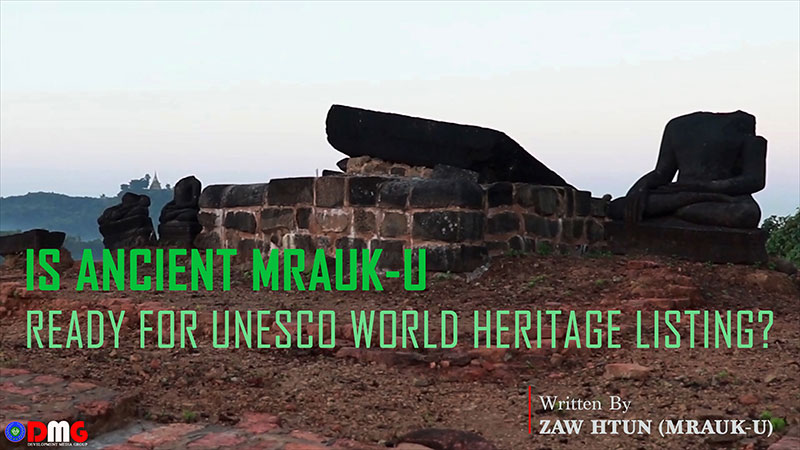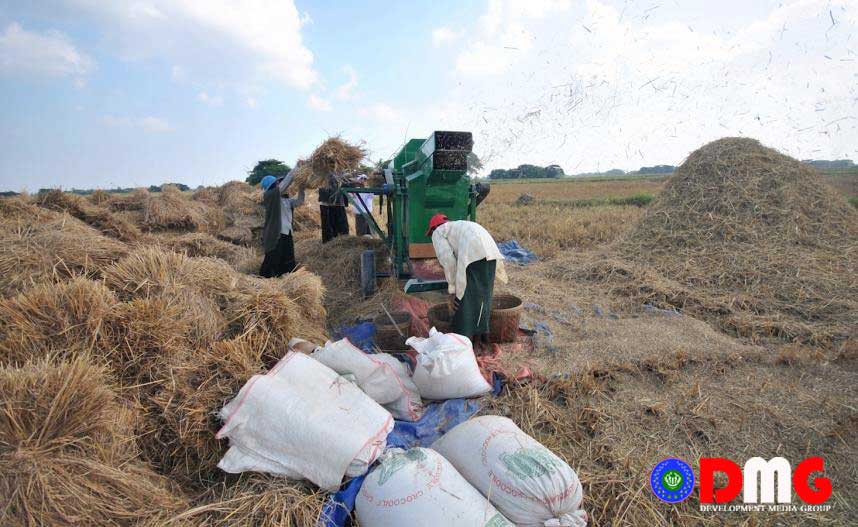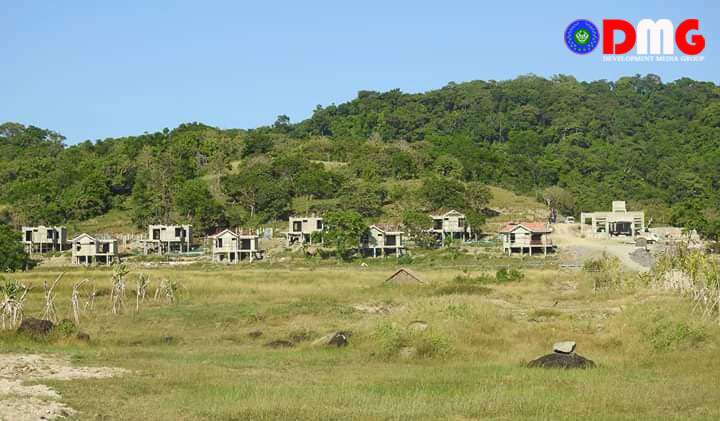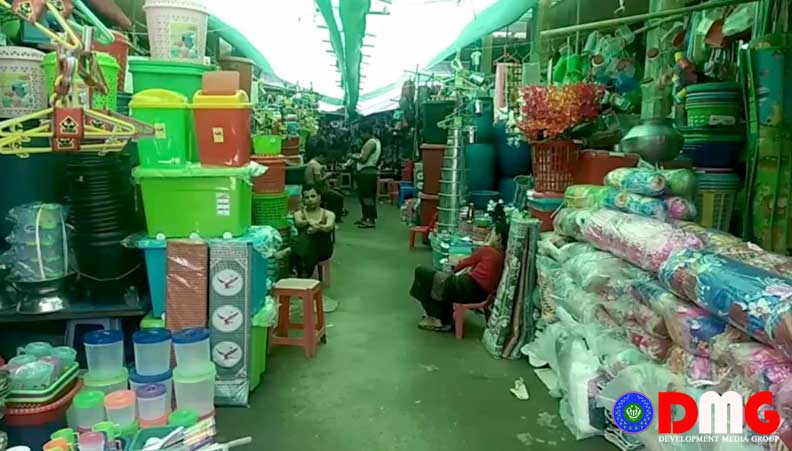- Junta unable to hold elections in dozens of wards and village-tracts in Sittwe, Kyaukphyu
- Fighting escalates between Myanmar military, Arakan Army in Ayeyarwady Region
- Regime steps up civilian arrests in Sittwe
- ULA safeguards Mrauk-U's ancient heritage
- Arakan on the Edge: What the DMG Landmine Impact Report Reveals About Myanmar's Deepening Humanitarian Crisis
Is Ancient Mrauk-U Ready for UNESCO World Heritage Listing?
The ruling government must be able to maintain the stability of the archeological zone, and must be able to effectively manage the archeological site and enforce the archeological heritage protection law. At present, the government has been extremely weak in taking responsibility for protection of archeological sites in Myanmar.
28 Sep 2021

Written By Zaw Htun (Mrauk-U)
Mrauk-U is located in the middle of the hills between the Kaladan River and Lay Myo River, and was an ancient royal capital. Mrauk-U was the most revered city for the Arakanese people and one of the longest reigning ancient cities in Myanmar.
Mrauk-U has bitterly gone through generations of Burmese rule, British rule, and Japanese rule, and has had a life of nearly 600 years. A World Heritage Site listing is simply a UNESCO recognition, but it is not unimportant.
If an area is inscribed on the World Heritage List:
- Not only the people but also the whole world has a responsibility to preserve this cultural heritage;
- Technical assistance will be available to systematically preserve this ancient heritage;
- Materials and financial support needed to preserve this heritage will be available;
- Heritage-based tourism will flourish;
- Training schools based on archeology and tourism will emerge (such as a tourism training school, archaeological institute, and other cultural heritage schools, etc.);
- The history of Arakanese people will be more easily presented to the world: Anyone will be able to easily find out about Arakan’s national identity and history with the flick of a finger online, thanks to the increased internet exposure that a World Heritage listing will bring.
The word “development” has become synonymous with the words “World Heritage” in the Mrauk-U region.
Mrauk-U’s unrivaled archeological heritage has been featured in newspapers and journals, as well as discussed in forums. It has also been the subject of an unprecedented discussion on social media. The government led by Daw Aung San Suu Kyi, which came to power following the 2015 election, came to terms with the Mrauk-U cultural heritage project, and made practical moves toward its listing as a World Heritage site. These were among the first steps that pushed the once forgotten Mrauk-U region into a major candidate for World Heritage listing.
On the other hand, with a growing population has come a lot of infrastructure such as houses, bridges, hospitals, schools, etc., which has further affected the Mrauk-U heritage area. With very little enforcement of the archaeological protection law, the number of houses and shops has increased exponentially. In contrast to the ancient heritage, modern buildings are growing day by day. Wealthy people are buying and competing for land by speculating. Even non-local financiers are secretly buying large tracts of land and competing to build big hotels. Entrepreneurs are preparing for future tourism endeavours.
It is heartbreaking for the Mrauk-U cultural heritage area to see karaoke shops (KTVs) built right next to religious buildings. Currently, the cultural heritage of Mrauk-U is also being affected by mismanagement. When preserving an ancient heritage, it is important to ensure that it does not compromise on authenticity and design; that the use of materials, as much as possible, in the present day be as close as possible to those used in the past, and that only skilled workers be used. In practice, however, maintenance work is being carried out with almost no compliance with the abovementioned standards, leaving only apparent damage caused by such maintenance.
Since development is everyone’s dream, it is inevitable that the pioneers of development will be welcomed. However, the development plans and activities of an archaeological zone like Mrauk-U should not be at all like those of other areas. Mrauk-U is a combination of ancient infrastructural and fortification systems, natural heritage, and both tangible and intangible cultural heritages. Mrauk-U’s rich heritage should not have been allowed to be subjected to rapid or large-scale development projects without first undergoing thorough strategic and cultural heritage impact assessments by experts.
Archaeological heritage should not be damaged by any individual or organisation. If it has been damaged by an individual or organisation, it is a heritage crime. During the two years of fierce fighting from 2018 to 2020, the Myanmar military expanded its bases in the archeological zones and repeatedly fired artillery shells that endangered or damaged Mrauk-U’s cultural heritage. It is not possible to know the exact extent of the damage at this time due to the inability to conduct a heritage impact assessment for security reasons.
The best way to sustain Mrauk-U’s archaeological heritage is to add it to the UNESCO World Heritage List. Only under the auspices of UNESCO can the best protection be offered against the effects of man-made disasters, natural disasters and/or old age. However, UNESCO recognition is not the only measure of an ancient cultural heritage’s worth or merit. No matter how ancient Mrauk-U’s cultural heritage may be, it will not be possible to preserve and honour it without the cooperation of the ruling government and the local people.
The ruling government must be able to maintain the stability of the archeological zone, and must be able to effectively manage the archeological site and enforce the archeological heritage protection law. At present, the government has been extremely weak in taking responsibility for protection of archeological sites in Myanmar.
Local people should be involved in the effort to gain UNESCO recognition of Mrauk-U. Locals should avoid demolishing ancient walls and heritage sites, digging ditches and building squatter settlements and shops in historical sites, and living in a way that does not suit the archeological site. In addition, they must be able to show the world that they value their heritage, directly or indirectly. We need to prove our true love in action, rather than simply expressing our love and appreciation for our heritage.
The Mrauk-U archaeological site is a place of great pride, and remains an embodiment of UNESCO’s core standard of Outstanding Universal Value. Currently, a draft proposal for the UNESCO World Heritage Site listing of Mrauk-U has been submitted to the UNESCO World Committee in Paris. If the final proposal is submitted by January 2022, archaeological experts will visit Mrauk-U to evaluate the details of the proposal.
Then, it will be decided whether Mrauk-U’s cultural heritage will be recognised as a World Heritage Site at the UNESCO Conference in 2023. To be recognised by UNESCO as a World Heritage Site, Outstanding Universal Value will be selected on the basis of six criteria based on culture and four factors based on nature, for a total of 10 criteria. The Mrauk-U archaeological zone remains strongly in line with these 10 criteria.
However, in the hopes of accessing UNESCO recognition, protection, management, authenticity and integrity of the properties must also be enhanced. In hopes of securing a UNESCO World Heritage listing, we must keep a close eye on the deterioration and destruction of the ancient Mrauk-U region.




















